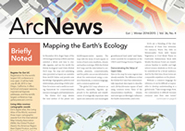Managing GIS, A column from members of the Urban and Regional Information Systems Association

At the Third High Level Geospatial Information Management Forum, held in October 2014 during the 7th URISA Caribbean GIS Conference at the Santa Barbara Resort in CuraÇao, senior personnel from the public and private sectors and academia discussed strategies for addressing the geospatial information management challenges faced by Caribbean states.
Given their geography, the global economic crisis, and the increasing need to provide sustainable futures for their people, Caribbean states have recognized the importance of collecting, managing, and using geospatial information to make informed decisions to facilitate the management of their resources and support national development.
At a strategic visioning session during the 3rd Caribbean URISA GIS Conference in November 2006, 60 participants representing 15 countries agreed that to facilitate practical and efficient utilization of geotechnologies in a coordinated manner throughout the wider Caribbean, a number of barriers and issues must be addressed. The resolution they prepared addressed 10 areas of concern that included the need for a regional spatial data infrastructure (SDI) coordinating body, the importance of geotechnologies (including GIS, global navigation satellite systems, and remote sensing), the need for capacity building, and the development of SDI policy and legislation.
Focusing on SDI Development
Subsequent regional meetings on developing a regional SDI were held under the URISA Caribbean chapters umbrella. The decision to address 5 of the 10 issues considered relevant to SDI development in the Caribbean was made at the first high-level meeting.
The five challenges chosen were
- Creating a regional institutional framework for geospatial information management
- Capacity and capability building
- Accessing fundamental datasets and regulating the quality of spatial data
- Creating a common regional geodetic infrastructure
- Leveraging trends in information technology
Creating a Framework for Geospatial Information Management
Countries such as the Bahamas, Belize, Guyana, Jamaica, St. Lucia, and Trinidad and Tobago have taken serious steps in developing national SDIs. This indicates the potential that exists for developing a regional framework.
However, an appreciable amount of work will be required to obtain the support of the heads of government and private sector companies and lobby regional bodies such as the Caribbean Community Secretariat (CARICOM) to create an institutional body that possesses the supporting policies and framework that will facilitate the creation, management, and exchange of regional geospatial information.
Capacity and Capability Building
Education and training are integral components for improved geospatial information use and management in the region as well as increasing the pool of trained personnel, particularly in the areas of GIS database management and design, data analysis, GIS applications programming, remote sensing, project management, web mapping, and network administration.
Ensuring Access and Quality
Access to fundamental datasets and regulation of the quality of geospatial information are imperatives for informed decision making and sustainable development. Caribbean states are challenged by similar geospatial data management problems such as lack of data exchange policies; inaccessible or inaccurate spatial data; no metadata; few mechanisms for data discovery; and prohibitively expensive data acquisition costs.
Creating a Regional Geodetic Infrastructure
There is a need for a common regional reference frame aligned with global initiatives to support geospatial information management. There have been a number of attempts to establish a regional datum. By working in collaboration with the United Nations Initiative on Global Geospatial Information Management (UN-GGIM) Americas and Sistema de Referencia Geocéntrico para las Américas (SIRGAS), a global datum will be adopted for the Caribbean.
Leveraging Trends in Information Technology
Information technology is constantly changing and encompasses a variety of platforms (mobile app, browser-based app, social media, cloud computing); sources (commercial off-the-shelf software or COTS, free and open source (FOSS) as well as digital cities, virtualization, and the use of big data. As these technologies develop, they extend the use of geospatial information and its benefits.
The application of expanding forms of information technology will be a great asset in the development of a regional infrastructure. Consequently, it is imperative that emphasis is placed on knowing what technologies exist and how they can be best applied to solve problems.
Results of the 2014 Meeting
The forums held in 2014 continued the discussions and reviewed the progress made from the Second Caribbean GIS High Level Meeting held in 2013. This meeting focused on capacity and capability building across the region. Strategies and action plans to address this challenge were identified.
Through the Ministries of Education and the Caribbean Examination Council, GIS will be formally introduced into geography and social sciences curricula at the secondary level, building on work already done in Jamaica. Jamaica’s GIS in Schools Education Programme (GISSEP) will be used as a pilot program for other countries that will show the benefits of GIS to students.
Increased emphasis will also be given to GIS Day events across the region. Professionals in each country are encouraged to support the planning and staging of annual GIS Day activities to increase the exposure of more students and teachers to GIS and show them its benefits. The private sector was also asked to participate and expose students to GIS technology through open houses, mentorship programs, internships, and even by holding annual GIS camps (such as the ones currently held by a private sector company in collaboration with government agencies in Jamaica and Guyana).
The University of the West Indies (UWI) in St. Augustine, Trinidad, will take the lead in preparing a Caribbean journal that will be affiliated with the URISA Journal. This journal will provide a body of knowledge and an avenue for GIS professionals to share and learn from and about regional work, best practices, research, and achievements. The UWI will also examine additional avenues through which it can support continuing education for GIS technicians and professionals across the region.
The Value of a Regional SDI
The major benefits derived from creating a regional SDI include cooperation across member states that will minimize research and development investment, share best practices, and facilitate technology transfer to meet the demand for geospatial data at the regional, national, and global levels. This is especially important given the limited resources of these islands. With greater collaboration and integration of the objectives of national SDIs, a regional SDI can be created. GIS technology can bring these states, which are predominately islands, together.
From all indicators, the Caribbean GIS executives at the 2014 meeting are committed to overcoming existing challenges and ensuring that geospatial technologies are recognized as indispensable tools for solving the region’s most enduring problems and building sustainable societies.

